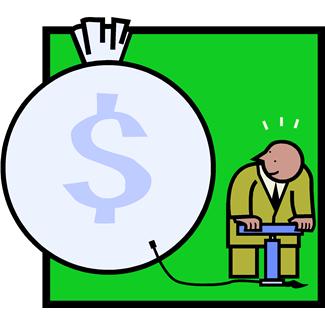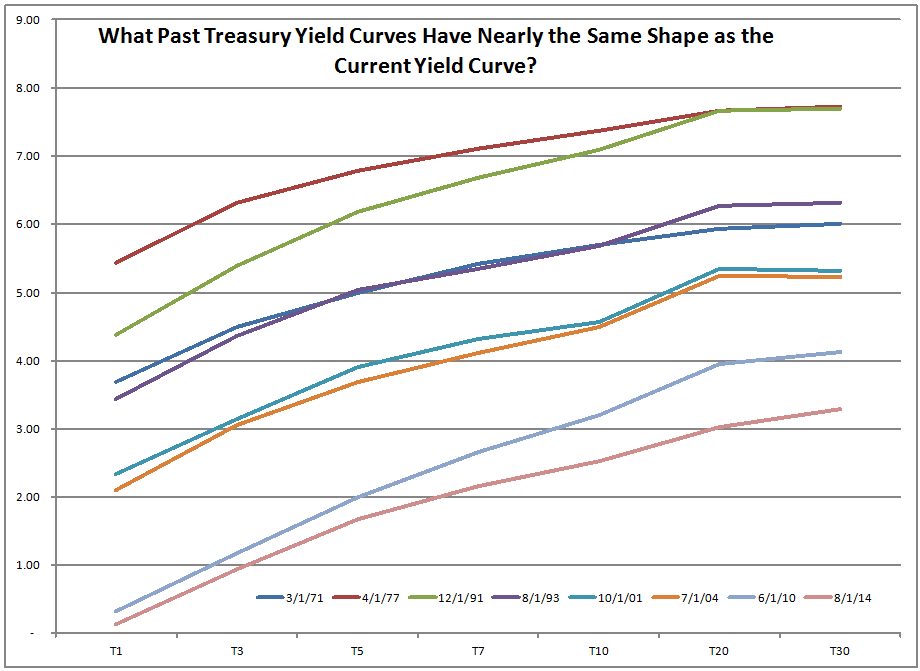This is the continuation of?The Shadows of the Bond Market?s Past, Part I. ?If you haven’t read part I, you will need to read it. ?Before I start, there is one more thing I want to add regarding 1994-5:?the FOMC used signals from the bond markets to give themselves estimates of expected inflation. ?Because of that, the FOMC overdid policy, because the dominant seller of Treasuries was not focusing on the economy, but on hedging mortgage bonds. ?Had the FOMC paid more attention to what the real economy was doing, they would not have tightened so much or so fast. ?Financial markets are only weakly?representative of what the real economy is doing; there’s too much noise.
All that said, in 1991 the Fed also overshot policy on the other side in order to let bank balance sheets heal, so let it not be said that the Fed only responds to signals in the real economy. ?(No one should wonder who went through the financial crisis that the Fed has an expansive view of its mandate in practice.)
October 2001
2001 changed America. ?September 11th led to a greater loosening of credit by the FOMC in order to counteract spreading unease in the credit markets. ?Credit spreads were widening quickly as many lenders were unwilling to take risk at a time where times were so unsettled. ?The group that I led?took more risk, and the story is told here. ?The stock market?had been falling most of 2001 when 9/11 came. ?When the markets reopened, it fell hard, and rallied into early 2002, before falling harder amid all of the scandals and weak economy, finally bottoming in October 2002.
The rapid move down in the Fed funds rate was not accompanied by a move down in long bond yields, creating a very steep curve. ?There were conversations among analysts that the banks were healthy, though many industrial firms, like automobiles were not. ?Perhaps the Fed was trying to use housing to pull the economy out of the ditch. ?Industries that were already over-levered could not absorb more credit from the Fed. ?Unemployment was rising, and inflation was falling.
There was no bad result to this time of loosening — another surprise would lurk until mid-2004, when finally the loosening would go away. ?By that time, the stock market would be much higher, about as high as it was in October 2001, and credit spreads tighter.
July 2004
At the end of June 2004, the FOMC did its first hike of what would be 17 1/4% rises in the Fed funds rate which would be monotony interspersed with hyper-interpretation of FOMC statement language adjustments, mixed with the wonder of a little kid in the back seat, saying, “Daddy, when will we get there?” ?The FOMC had good reason to act. ?Inflation was rising, unemployment was falling, and they had just left the policy rate down at 1% for 12 straight months. ?In the midst of that in June-August 2003, there was a another small panic in the mortgage bond market, but this time, the FOMC stuck to its guns and did not?raise rates, as they did for something larger in 1994.
With the rise in the Fed funds rate to 1 1/4%, the rate was as high as it was when the recession bottomed in November 2002. ?That’s quite a long period of low rates. ?During that period, the stock market rallied vigorously, credit spreads tightened, and housing prices rallied. ?Long bonds stayed largely flat across the whole period, but still volatile.
There were several surprises in store for the FOMC and investors as ?the tightening cycle went on:
- The stock market continued to rally.
- So did housing.
- So did long bonds, at least for a time.
- Every now and then there were little panics, like the credit convexity panic in May 2005, from a funky long-short CDO bet.
- Credit complexity multiplied. ?All manner of arbitrage schemes flourished. ?Novel structures for making money off of credit, like CPDOs emerge. ?(The wisdom of finance bloggers as skeptics grows.)
- By the end, the yield curve invests the hard way, with long bonds falling a touch through the cycle.
- Private leverage continued to build, and aggressively, particularly in financials.
- Lending standards deteriorated.
We know how this one ended, but at the end of the tightening cycle, it seemed like another success. ?Only a few nut jobs were dissatisfied, thinking that the banks and homeowners were over-levered. ?In hindsight, FOMC policy should have moved faster and stopped at a lower level, maybe then we would have had less leverage to work through.
June 2010
15 months after the bottom of the crisis, the stock market has rallied dramatically, with a recent small fall, but housing continues to fall in value. ?There’s more leverage behind houses, so when the prices do finally fall, it gains momentum as people throw in the towel, knowing they have lost it all, and in some cases, more. ?For the past year, long bond yields have gone up and down, making a round-trip, but a lot higher than during late 2008. ?Credit spreads are still high, but not as high as during late 2008.
Inflation is low and volatile, unemployment is off the peak of a few months earlier, but is still high. ?Real GDP is growing at a decent clip, but fitfully, and it is still not up to pre-crisis levels. ?Aside from the PPACA [Obamacare], congress hasn’t done much of anything, and the Fed tries to fill the void by expanding its balance sheet through QE1, which ended in June 2010. Things feel pretty punk altogether.
The FOMC can’t cut the Fed funds?rate anymore, so it relies on language in its FOMC Statement to tell economic actors that Fed funds will be “exceptionally low” for an “extended period.” ?Four months from then, the QE2 would sail, making the balance sheet of the Fed bigger, but probably doing little good for the economy.
The results of this period aren’t fully known yet because we still living in the same essential macro environment, with a few exceptions, which I will take up in the final section.
August 2014
Inflation remains low, but may finally be rising. ?Unemployment has fallen, much of it due to discouraged workers, but there is much underemployment. ?Housing has finally gotten traction in the last two years, but there are many cross-currents. ?The financial crisis eliminated move-up buyers by destroying their equity. ?Stocks have continued on a tear, and corporate credit spreads are very tight, tighter than any of the other periods where the yield curve was shaped as it is now. ?The long bond has had a few scares, but has confounded market participants by hanging around in a range of 2.5%- 4.0% over the last two years.
There are rumblings from the FOMC that the Fed funds rate may rise sometime in 2015, after 72+ months hanging out at 0%. ?QE may end in?a few more months, leaving the balance sheet of the Fed at 5 times its pre-crisis size. ?Change may be upon us.
This yield curve shape tends to happen over my survey period at a time when change is about to happen (4 of 7 times — 1971, 1977, 1993 and 2004), and one where the?FOMC will raise rates aggressively (3 of 7 times — 1977, 1993 and 2004) after fed funds have been left too low for too long. ?2 out of 7 times, this yield curve shape appears near the end of a loosening cycle (1991 and 2001). ?1 out of 7 times it appears before a deep recession, as in 1971. 1 out of 7 times it appears in the midst of an uncertain recovery — 2010. 3?out 7 times, inflation will rise significantly, such as in 1971, 1977 and 2004.
My tentative conclusion is this… the fed funds rate has been too low for too long, and we will see a rapid rise in rates, unless the weak economy chokes it off because it can’t tolerate any significant rate increases. ?One final note before I close: when the tightening starts, watch the long end of the yield curve. ?I did this 2004-7, and it helped me understand what would happen better than most observers. ?If the yield of the long bond moves down, or even stays even, the FOMC probably won’t persist in raising rates much, as the economy is too weak. ?If the long bond runs higher, it might be a doozy of a tightening cycle.
And , for those that speculate, look for places that can’t tolerate or would ?love higher short rates. ?Same for moves in the long bond either way, or wider credit spreads — they can’t get that much tighter.
This is an unusual environment, and as I like to say, “Unusual typically begets unusual, it does not beget normal.” ?What I don’t know is how unusual and where. ?Those getting those answers right will do better than most. ?But if you can’t figure it out, don’t take much risk.
 I remember sitting in my intermediate macroeconomics class at Johns Hopkins, when the Professor was trying to develop the concept of the Phillips Curve, which posits a trade-off between labor unemployment and price inflation, at least in the short run. ?The time was the Fall of 1980, and macroeconomics was trying to catch up with what happened with stagflation, because that was not something that expected would come from their policy recommendations that offered the politicians a free lunch.
I remember sitting in my intermediate macroeconomics class at Johns Hopkins, when the Professor was trying to develop the concept of the Phillips Curve, which posits a trade-off between labor unemployment and price inflation, at least in the short run. ?The time was the Fall of 1980, and macroeconomics was trying to catch up with what happened with stagflation, because that was not something that expected would come from their policy recommendations that offered the politicians a free lunch.





